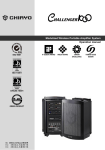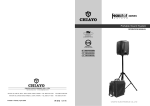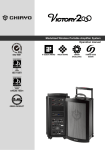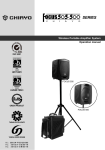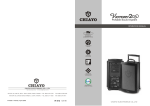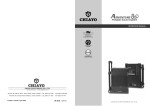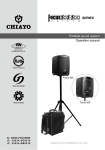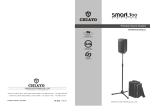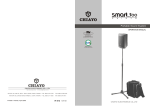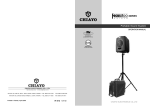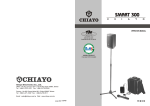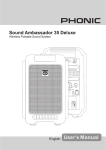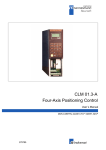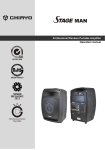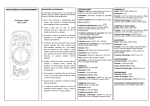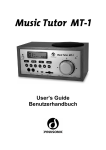Download Chiayo Challenger 1000 Operating instructions
Transcript
Portable Sound System Portable Sound System OPERATION MANUAL GOOD DESIGN PRODUCT IT'S VERY WELL MADE IN TAIWAN Design Award HKEIA AWARD For Outstanding Innovation and Technology Products GREEN PRODUCT It has been RoHS Compliant CHIAYO ELECTRONICS CO., LTD. http://www.chiayo.com.tw OFFICE: 30, LANE 27, SEC.4. JEN-AL ROAD, TAIPEI, TAIWAN / TEL: 886-2-2741-5741 FACTORY: 88, CHUNG HSIAO STREET 2, CHIAYI, TAIWAN. / TEL: 886-5-271-1000 Printed in Taiwan, April 2008 IC︰3563A-CHALLENGER E-mail: [email protected] FAX: 886-2-2752-5242 FAX: 886-5-276-7611 12I1150 IC︰3563A-SQ5016 IC︰3563A-SM5016 Challenger 1000 Operation Manual Maintenance-free Lead Acid battery Congratulation and thank you for the purchase of this all-in-one portable sound system. To ensure a trouble-free operation, please read the manual thoroughly to fully understand its controls and functions. Guidelines for maintenance-free Batteries: 1. Battery should operate at temperatures between 15°C ~ 50°C. To ensure a longer life span, it should be kept between 5°C ~ 35°C. For optimum result, 20°C ~ 25°C will be ideal. When temperature falls 15 degrees below zero, battery will undergo some changes in its chemical contents and therefore cannot be recharged. Operating the battery at higher temperature will result in higher capacity but shorter lifespan, whereas lower temperatures operation has a longer lifespan but less capacity. 2. If the battery is not recharged 72 hrs after it is completely used, it will be permanently damaged. 3. When the battery is being charged, the internal gases will be electrolyzed into water at the negative charge, maintaining the battery’s storage abilities with no water added. However, erosion at the charged ends of the battery will cause poor performance. 4. The battery’s cycle lifespan ( no. of charge and discharge cycle ) is determined by the degree at which power is dissipated., especially the degree of discharged each time it is used and the recovery charging method. For normal use, the battery can be used for longer hours when less power is dissipated each time and vice versa. At 25°C, maintenance-free batteries could be charged 150 ~ 200 times at 100% discharge each time. 5. Decrease in capacity, internal short circuit, deformation in appearance, erosion of charged ends and decrease in open circuit voltage are symbols indicating battery is approaching the end of its life cycle. 6. When two batteries are used in parallel connection, the resistance of the cables should be kept equal. Followings are various Challenger 1000 variants : 1. Challenger 1000 portable sound system only. ( Fig. 1 ) 2. Challenger 1000 with CD / USB Player ( Fig.2 ) 3. Challenger 1000 with CD / USB Player & Tape Deck. ( Fig.3 ) 4. Challenger 1000 with CD / USB Player & Digital Recorder.( Fig.4 ) All the above versions can be installed with 1 or 2 wireless receiver module(s). The wireless receiver module can be in either UHF or VHF band and is a PLL synthesized type with 16 preset frequencies. Configuration : All versions of Challenger 1000 series come equipped with the following : 1. AC power cord. 2. 1 or 2 or no wireless receivers. 3. 1 or 2 transmitters, either handheld or bodypack transmitter ( except version with no module installed ). Optional accessories : 1. Weather proof dust cover. 2. Tripod stand 3. Companion powered speaker ( Slave speaker ).( Fig. 5 ) 4. Companion passive speaker C-SP. ( Fig. 6 ) 5. Wired microphone. Matching transmitters: Transmitter types Frequency band Transmitters Battery used Beltpack Handheld Beltpack UHF VHF SQ-816 SM-216 SM-816 SQ-216 SQ-5016 SM-5016 SQ-916 SM-316 SM-916 SQ-316 Handheld AAx2 AAx3 9Vx1 AAx2 No. of channel 1 AAx3 9Vx1 16 AAx3 9Vx1 AAx3 9Vx1 Properties of the Lead Acid Battery: 1. Has no memory effect. Can be charged at anytime, even when the recharge indication light is not on. 2 .Performance and efficiency are affected by changes in the environment, especially temperature and humidity. (Best operated between 20°C ~ 25°C) 3. Battery discharge naturally according to a certain pattern even not in use. For best performance and a prolonged lifespan, it should be recharged every month even when not in use. 4. Under normal circumstances, battery could last for about a year. 5. When the battery’s life expires, possible indicators include internal short-circuit, decrease in capacity, deformation in appearance, erosion of charged ends and decrease in operating voltage. User’s Precautions: 1. For first-time use, charge the battery for 10 hrs until it is fully charged. 2. To maintain performance and lifespan, if product has not been used for 3 months after the initial shipment, please fully charge the battery. 3. Before each use, it’s advisable to charge the battery to its full capacity. 4. The average lifespan of the battery is one year. The user is advised to change the battery after one year of use. 5. The current consumption is in direct ratio with load current. The more current consumption, the less the operation time. 6. SMART and FOCUS operate on one 12V/2.7AH battery. ADVENTURE, CHALLENGER, and VICTORY operate on two 12V/4.5AH batteries. 34 Challenger 1000 ( Master ) ( Basic configuration ) 5.The audio cable of VHF transmitters also serve as antenna. The length of the cable is cut according to the specific frequency range. Do not alter the length or mix around the cable of different transmitters. The use of wrong audio cable will affect the antenna efficiency of the transmitter! 6.Use only brand new Alkaline batteries. Do not use " general purpose " batteries . When batteries are weak, replace all the batteries at the same time. Do not mix and use new and old batteries together. 7.Position the receiver such that it has the least possible obstructions between it and the transmitter. Line of sight is best ! A. Receiver module 1 SDR-6216m SDR-6216m B. Receiver module 2 8.The transmitter and the receiver should be as close as possible but not less than 1m. 9.A receiver cannot receive signals from two or more transmitters simultaneously. A B A B 10.Turn the transmitter off when it is not in use. Remove the batteries if it is not to be used for a period of time. 11.Antennas form an integral part of the receiver and must be installed when in operation. 1. MIC IN. 2. LINE-IN VOL. 3. TAPE control 4. BASS 5. TREBLE 5 4 6. MASTER VOL. 7. MIC IN 1 2 6 3 7 4 5 9 8 6 10 8. LINE IN / OUT 9. VOICE PRIORITY 10. ACTIVE OUT ( MASTER OUT ) 11 10 12 13 13 1414 12 15 16 7 8 15 AC IN~ 90~260 VAC(150W) 47~63Hz 5A Max 11. Battery low LED 11 12. Charging indicator 13. FUSE 9 14. 24~32V DC-IN 16 20 17 18 17 15. AC-IN 16. POWER 19 17. EXT.SP Fig. 1 33 2 Challenger 1000 ( Master ) (CD / USB Player version ) Operation of wireless microphones Chiayo Transmitters and Receivers have factory preset to allow immediate use after switch-on. However, please note that the transmitter Sensitivity function is dependent on application such as close proximity singing or tripod mouth speech. To avoid over-modulation and distortion, please check whether the preset sensitivity level is suitable for your particular application. For close proximity singing purposes, please select the lowest sensitivity level whereas for tripod mount speech purposes, please select a higher sensitivity level. SDR-6216m If you have made changes to the setting, after making proper selection on Transmitter and Receiver settings the system is ready for operation. However, both antennas of the receiver must be installed to assure a good reception. SDR-6216m A B 1. LCD Display B C D 2. PLAY/PAUSE E K A H F G J I 3. STOP First, turn on the receiver by switching the Power/Volume control slowly till its LCD lights up. The LCD display will show the information last stored. Switch on the matching transmitter with the correct matching frequency. The LCD display will show the information last stored. 4. SKIP 5. EJECT 6. CD SELECTOR 7. USB SELECTOR 8. FOLDER SKIP The LED RF indicator on the receiver front panel will light on to indicate that RF signal has been received. If this is not the case, please check and verify the frequency setting on both transmitter and receiver. When transmitter is moving around, the Diversity A/B switch will light on alternately to indicate the stronger reception on either A or B antenna. 9. IR LED 10. USB INPUT 11. POWER/VOL. Caution and tips on how to obtain the best results. 1 2 3 4 5 6 7 8 9 10 11 12 13 15 16 CD player remote control. 2.For PLL-16-frequency agile version, before operation please make sure that the corresponding receiver MUST have the same frequency group and channel number as the transmitter. 14 3.Before making any channel change on transmitters, please switch off the power supply. The synthesized program works in such a way that a change of channel will only take place after a power off and on action. Otherwise, the previously selected frequency will stay unchanged. 20 AC IN~ 90~260 VAC(150W) 47~63Hz 5A Max 17 1.Before inserting the batteries, please make sure that they are inserted according to the correct polarity. 18 19 4.After making a channel change, please make sure that the corresponding change is made on the matching receiver as well. To be exact, changes MUST be made at both the transmitter and receiver. Fig. 2 3 32 Challenger 1000 ( Master ) (CD / USB Player & Tape Deck Version ) Beltpack Transmitter SM-816(UHF) / SM-216(VHF) Battery installation This transmitter uses 3 pieces of " AA " size batteries (Alkaline battery is recommended ). To install or remove the batteries, press the release buttons at the edges of the transmitter to open or close the cover as illustrated ( Fig.1 ). SDR-6216m Fig.1 SDR-6216m A Beltclip installation B Chargi ng point s This specially designed detachable beltclip allows the user to wear the transmitter with antenna pointing upward or downward as illustrated. To wear the transmitter with the transmitter pointing upward, install the belt-clip as in Fig.2. To wear the transmitter with the antenna pointing downward, please install the belt-clip as in Fig.3. a. Eject key a b Chargi ng point s Fig.2 b. Counter c. Variable Speed control Fig.3 d. Auto reverse indicator e. Single reverse indicator c f. Single side indicator Channel selection and gain adjust f e d Channel selector and gain adjust are hidden in the designated cover of the front as illustrated. To make channel selection and gain adjust, please press the designated cover and flip it open as illustrated. Channel selection can be made by rotating the selector with a small screw driver. Gain adjust for Lavalier and Headset microphones can be done by adjusting the MT switch, whereas GT switch is for the gain adjust of electric Guitar and other highimpedance line level inputs. 1 m 2 l k 3 5 4 i j g h g. Mode selector h. Fast forward i. Forward play 6 7 8 9 10 MT j. Stop k. Reverse play l. Fast reverse Channel Selector 11 11 12 13 15 16 GT m. Rec 14 20 AC IN~ 90~260 VAC(150W) 47~63Hz 5A Max 17 18 19 Fig. 3 31 4 Challenger 1000 ( Master ) (CD / USB Player & Digital Recorder version ) Installation of cable restraint To prevent contact noise caused by constant tension applied to the connector,,a cable restraint is designed such that tension is totally reduced when it is properly used. When the audio cable go through the cable restraint, it could prevent sweat from going directly into the electronic board via the connector. This is another advantage of the cable restraint. SDR-6100m SDR-6100m A B 2 3 4 5 6 7 8 9 11 1 10 a. POWER f Digital Recorder Player EAR c e d l k POWER a g LINE REC b SD card p o MIC VOL L/L+R h EQ A-B MODE STOP F MIC IN j i VO/M3 DEL. PLAY m C n q R b. LCD Display c. EAR d. USB VOL Installation of Lavalier / Headset microphones or instrument inputs e. SD Card Slot f. LINE▲▼ Depending on customer requirements, Lavalier / Headset microphone or instrument inputs could be connected to the transmitter via the audio input connector. User is free to choose the various input sources but is advised to take note that connector used must be compatible to each other. The pin configurations of mini XLR connector are as follow figure. g. EQ 1 2 3 5 4 h. REPEAT mini XLR connector i. LED INDICATOR j. 6 7 8 9 10 GT IN k. REC l. STOP m. MODE. 11 12 13 15 16 14 OFF ON 2 3 4 1 POWER n. PLAY ll o. MIC VOL p. MIC IN q. VOL 20 AC IN~ 90~260 VAC(150W) 47~63Hz 5A Max 17 18 19 ANTENNA MT IN GND POWER SWITCH PHANTOM POWER Fig. 4 5 30 Challenger Slave The Challenger Slave is an active ( powered ) speaker unit with built-in switching power supply as well as rechargeable batteries, complete with similar charging circuit as that of the Challenger 1000 Master unit. It is an extended and indispensable member of the Challenger Audio Link system. Beltpack Transmitter SM-916(UHF) / SM-316(VHF) Battery installation Antenna(SM-916) SM-916/SM-316 use a 9V battery. To insert the battery, first open the battery compartment cover by pressing the cover downward till the door flips open by itself (see below picture). When installing the battery, please beware of correct polarity. To put back the cover of the battery compartment, one has to press the cover in upward direction until it is locked. Battery status Indic ator Power swit ch Cable restrain t Audio in put Connector Battery Compartment Mik e clip Capsuale Fig.1 11. Speaker out (switched) Channel selection and gain adjust 12. Speaker out Channel selector and gain adjust are hidden in the designated cover of the front as illustrated. To make channel selection and gain adjust, please press the designated cover and flip it open as illustrated. Channel selection can be made by rotating the selector with a small screw driver. 19 20 13. 24-32V DC input 21 14. Fuse 15. Battery low indicator 11 13 12 15 16 18 14 16. Battery status indicator 17. AC input 18. Charging indicator 19. Slave IN Gain adjust for Lavalier and Headset microphones can be done by adjusting the MT switch, whereas GT switch is for the gain adjust of electric Guitar and other high- impedance line level inputs. 20. Slave OUT 21. Slave VOL. MT Channel Selector 17 GT 29 Fig.5 6 Challenger Speaker ( C-SP ) The Challenger Speaker is a passive companion speaker for the Challenger 1000 series. It is for connection to the switched or unswitched speaker outs of the Challenger 1000 ( Master ) or the Challenger Slave units. 22. Speaker IN 23. Speaker OUT 22 23 Fig. 6 7 28 Operating procedures UHF Beltpack Transmitter SM-5016 Parts & Functions 7 8 9 10 11 Antenna Battery weak / audio mute indicator Audio mute switch Mini-XLR connector Power ON / OFF switch LCD display Charging port Cover release button Charging contacts Lavalier microphone Mic clip 12 13 1516 14 12 13 14 15 16 SET UP DOWN GT MT Battery installation SM-5016 uses 2 pieces of " AA " size batteries (Alkaline battery is recommended ). To install or remove the batteries, press the release buttons at the edges of the transmitter to open or close the cover as illustrated below. 27 After unpacking the unit for the first time, please charge the unit for about 4-5 hours before any operation. This is absolutely necessary as the built-in rechargeable battery might have been discharged naturally due to long shipment and storage time, even though it has been fully charged in the factory prior to shipment. To charge the battery, just plug in the AC cord into the AC IN of the unit and charging will start automatically. During the charging process, the charging indicator LED will flash GREEN. When GREEN LED stays glow permanently, battery is then fully charged and normal operation could now be started. While charging, the unit could also be operated simultaneously. To operate this portable sound unit, switch on the main POWER switch, the GREEN LED above it will glow. However, if the RED LED also glows at the same time, it means the battery is getting weak and a recharge of the battery is necessary. The main POWER switch does NOT switch on the Wireless receiver module and Tape deck/ CD player/ Digital Recorder as each of them has dedicated Power / Volume control switch. To operate each of them, you must switch them on accordingly. Operation of wireless microphone system The receiver installed on Challenger-1000 is a PLL-synthesized type with 16 preset frequencies for selection. It has an UP, DOWN buttons and 2 * 7-segment LED indicator. To operate the wireless system, just switch on the power / volume switch on the module front panel and the matching transmitter. Please ensure that the channel setting on both the wireless microphone and receiver module are the same before operation. 8 16-Channel wireless microphone system ( UHF ) To operate, switch on the PWR / VOL switch, the 2*7-segment LED indicator will light up and the last used channel in memory will be displayed. Channel setting can be changed by Pressing either the ▲/▼button. Switch on the corresponding transmitter. RF or Diversity indicator A or B will light up when both are in the same channel setting. The movement of the transmitter causes diversity indicator A or B to light up alternately. UHF SDR-6216m TRUE DIVERSITY RECEIVER PWR/Min Max Handheld Transmitter SQ-816(UHF) / SQ-216(VHF) Parts & functions When both transmitter and receiver are on, speak into the microphone and rotate the dedicated volume control and master volume control, amplified sound could be heard from the speaker. 1. Capsule with metal grille 2. Battery normal indicator (Green) When interference occurs, turning the SQ switch in clockwise direction will make it diminish 3. Battery low indicator (Red) or disappear completely. 4. Power on/off switch However if interference noise persists even though SQ is at max. position, it means this 5. Channel switch channel is useless at this location. Press ▲/▼or SCAN to search for the next clean channel. 6. Charging port The corresponding transmitter channel setting must also be changed accordingly to match the receiver selection. The battery indicator LED on receiver panel serves as remote transmitter battery status monitor. Lighting up of this monitor LED indicates transmitter battery is weak ! Battery installation 16-Channel wireless microphone system( VHF ) To operate, switch on the PWR / VOL switch, POWER LED will light up. Channel setting can be changed by the rotary switch. Switch on the corresponding transmitter. RF or Diversity indicator A or B will light up when both are in the same channel setting. The movement of the transmitter causes diversity indicator A or B to light up alternately. SDR-216M VHF PLL TRUE DIVERSITY RECEIVER SQ-816/SQ-216 transmitter requires 3 pieces of " AA " size battery to operate. Please insert the batteries according to the correct polarity as indicated. To open the battery compartment, press and slide down the cover until it clicks and locks. Further sliding movement will remove the cover. When both transmitter and receiver are on, speak into the microphone and rotate the dedicated volume control and master volume control, amplified sound could be heard from the speaker. When interference occurs, turning the SQ switch in clockwise direction will make it diminish or disappear completely. However if interference noise persists even though SQ is at max. position, then use rotary switch to change it to another channel and press the TEST button. When neither RF A nor B indicator light up, then this particular channel is considered clean. The corresponding transmitter channel setting must also be changed accordingly to match the receiver selection. 9 26 Changing capsule Operating the dynamic wired microphone. This microphone has a modular design. To change or replace a capsule, Open the grill to pull out and plug in the capsule as shown in the following figure. To use a cable microphone, simply plug it into any MIC IN socket. The unique Neutrik combo socket accepts both phone and Cannon jack. Rotate the dedicated volume control knob and master volume control, amplified sound could be heard from the speaker when voice is spoken into the cable microphone. Operation of system with CD / USB Player. This operation is valid for version of Challenger 1000 with built-in " CD / USB Player" To operate, push the Power/Vol button to turn on the player. The LCD panel on the player will be lighted up and normal operation is ready. To insert a CD, just push it into the CD slot and the mechanism will suck it in automatically. Rotate the volume control knob to adjust the volume of the player. For Bass and Treble setting, adjust the individual Bass and Treble controls. For more details, please refer to the instruction on " CD / USB Player" controls and functions. Operation of system with Digital Recorder. Operating instructions This operation is valid for version of Challenger 1000 with built-in " Digital Recorder " 1. Before operation, please check and make sure that transmitter & receiver are of matching frequency or frequency group. 2 .To switch on the microphone, put the switch to "ON" position. The green LED indicator will light on to indicate that battery is fresh. When RED LED light on, it indicates that battery is weak, thus a replacement is necessary. 3. For best result, alkaline battery is recommended. Please remove the battery if the transmitter is not to be used for a longer period. 4.When necessary, mic capsule could be replaced by pulling out and plugging in the new one, either dynamic or condenser for SQ-916. To operate, first turn on the Master power switch and then press the designated power button of this module. The LCD display will be lighted up and Volume setting can be done by rotating the knob. For Bass and Treble setting, adjust the designated controls respectively. For more details, please refer to the instruction of " Digital Recorder " controls and functions. Operation of system with Tape Deck. This operation is valid for version of Challenger 1000 with built-in " Tape Deck ". Rotate the volume control knob of the TAPE / CD control to adjust the volume of the Tape deck. For Bass and Treble setting, adjust the designated controls respectively. For more details, please refer to the instruction of " Tape Deck " Controls and functions. 25 10 Handheld Transmitter SQ-916(UHF) / SQ-316(VHF) Audio Link Operation Schematic diagram Parts & functions MASTER SLAVE 1. Capsule with metal grille 2. Battery indicator 3. Sensitivity switch 4. Power on/off switch 5. Battery cover 7. Color cap SLAVE Audio Link Connection Plan SLAVE Battery installation SLAVE SLAVE SLAVE SQ-916/SQ-316 use a 9V battery for power. To change or replace the battery, please remove the color cap first, then press the bottom of battery compartment to release the cover as shown below. Pre ss When a Master unit is connected to one or several SLAVE units as follow, we called it an Audio Link Operation. The Challenger 1000 could be operated as MASTER only. The Challenger Slave can only be operated as SLAVE. Sensitivity switch In order to operate Audio Link, you must have a Challenger 1000 unit that operates as a MASTER. Only one unit is allowed to act as MASTER and the other(s) MUST This microphone has a sensitivity switch. For close mouth singing or normal speech, operate as SLAVE(s). A MASTER unit is capable of connecting up to about 20 please put the switch to L ( Low ) position. For tripod-mount speech, please put the SLAVE units. switch to N ( Normal ) position. To operate Audio Link, connect the Active Out ( 10 ) of the MASTER to the Audio Link IN ( 19 ) of the 1st SLAVE unit. The Out ( 20 ) of this SLAVE should be connected to the IN jack ( 19 ) of the 2nd SLAVE unit. Similar connection shall continue as such for the following SLAVE units. Volume Control ( 6 ) for MASTER or ( 21 ) for SLAVE. When used on the MASTER, it controls the MASTER as well as all the SLAVE units. When used on the SLAVE unit, it only controls that particular SLAVE unit volume. Maximum number of SLAVE units to be connected with a MASTER is about 20. 11 L N L Low Sensitivity Normal Sensitivity 24 N Voice Priority ( Ducking ) operation Voice Priority ( Voice overrides Music ) operation is only necessary when Tape or CD is playing. When the Voice Priority switch ( 9 ) is put to ON position, the ducking function will be activated. While the music is playing, a voice input from either a Wired or Wireless Microphone will temporary turn down the volume of the background music and voice could be heard clearly. Background music will return to its original setting when no audio input is entering the microphone for a certain time. However, if the microphone is not switch off, the reentering of music into the microphone will also activate the voice priority function. So, voice priority is best operated using microphones with on / off switch. Mechanical Parts All the Challenger 1000 ( Master ), Challenger Slave and the Challenger companion speaker ( C-SP ) enclosures have the identical mechanical parts as follow : Three-stage Trolley ( 24 ) Trolley release button ( 25 ) Handle ( 26 ) Wheels ( 27 ) Tripod mount bracket ( 28 ) 24 25 26 27 28 Remark : Please be advised that the trolley and wheels are designed for moving around on smooth surface and short distance only. It is NOT meant or built for heavy duty long distance transportation or on rough surfaces. Please DO NOT use the trolley as handle for going up and down the staircase. For going up and down the staircase, please use the Handle ( 26 ). 23 12 Operating the Tape Deck UHF Handheld Transmitter SQ-5016 To begin operation switch on the TAPE Power after the main power of challenger 1000 has been turned on. Parts and functions Keys Speed Control Eject Press this key for fast forward . Press this key for play in forward direction. Press this key to stop the tape. Press this key for play in reverse direction. Press this key for fast reverse. Press this key together with FP or RP key for recording. This key is pressed to select one of the following three modes. Active in Forward nor Reverse direction, the cassette tape will play to the end and stop automatically. This mode may be used for Record and Play. The cassette tape will play to the end, stop, reverse direction to the end of the second side and stop. This mode may be used for Record and Play. This mode provides continuous " Play " operation. It is not operable in Record mode, however, it will record one complete cycle if the recording is begun in the Forward direction. Normal tape speed at center position. Clockwise direction increases tape speed. Counter-clockwise direction reduces tape speed. This key is pressed for ejecting the tape. 5016 FF Fast Forward FP Forward Play Stop RP Reverse Play FR Fast Reverse Record Mode selector Functions 7. Lock / Unlock 8. Set 9. Up 10. Down 11. Charging port 12. Name plate 1. Microphone capsule module 2. Battery status LED 3. ON/OFF switch 4. LCD 5. Battery compartment 6. Rotating protective cap for controls (also serves as color identification cap) Changing of capsule First unscrew the metal grill from the housing and take out the capsule to be replaced. Then insert a new capsule. Either dynamic or condenser type can be chosen from location to location. Battery installation SQ-5016 microphone requires 2 pieces of " AA " size batteries to operate. Please insert the batteries according to the correct polarity as indicated. Caution Many batteries are known to have leakage problem of conductive and corrosive liquid. Please observe the rule to remove the batteries if they are not to be used for a longer period. Due to various unstandardized sizes ( diameters ) of " AA " batteries, this battery compartment is designed to accommodate the most common Alkaline batteries only. 13 22 Operating the CD / USB Player Simple DIY Trouble-shooting : No sound when one speaks to the wireless microphone Please verify the followings: 1.Main power switch of the system should be ON. When power on LED not lighted up, it means that the batteries are either weak or not charged. Please plug in the AC cable to charge the batteries. The rechargeable batteries have a life span of about 2 years. If they have reached their life expectancy, please change them to a fresh pair. 2.The power switch of the corresponding receiver module should be put to ON. This is indicated by the lighted power LED. When two wireless mics are used, both power switches of the receiver modules must be ON. 3.Wireless mic should be switched ON and verify that the battery is o.k. ( please refer to wireless microphone operating instruction ). 4.Please verify that the frequency on the wireless microphone and the corresponding built-in wireless receiver module are exactly of the same frequency group and channel. 5.Master volume control of the system should be turned on. No sound when Tape / CD player is used. Main power switch should be ON. When no light appears, it means that the batteries are weak. Please plug in the AC cable to charge the batteries. Tape / CD volume control is turned on but Master volume control not on. Ducking ( Voice Priority ) does not work Please ensure that the Voice Priority switch is put to ON position to activate the ducking circuitry. Audio Link does not work Only one OUT cable is connected from the MASTER to the IN jack of the 1st SLAVE unit. st The OUT of the 1 SLAVE goes to the IN of the next SLAVE and so on. No power supply 1.Battery is faulty 2.Battery is not charged. Installation of Receiver module To install the receiver module, first remove the blank panel covering the module compartment, position the module such that it fits exactly into the guide rail in the module compartment and push it to the end so that the gold finger connection plug firmly fits into the socket provided. To secure the receiver module to the Challenger rear panel, tighten the receiver panel with two screws. To remove the receiver module, first unscrew the two screws on the module front panel, pull up the trolley, follow instruction as shown in the picture and push out the module with a screw driver. 2 1 UHF Front remotable is an unique feature of Challenger 1000. User can easily control this CD player by clicking its remote from both front and rear Challenger 1000. To begin operation switch on the CD Power after the main power of Challenger 1000 has been turned on. Keys Functions UHF 21 Panel Remote When this key is pushed during CD stop, play will start after track search. When this key is pushed during CD is playing, then it is changed to pause. When this key is pushed during CD is pausing, then it is changed to play. When CD is not stop, if this key is pushed then CD will stop. STOP When press this key will change to cd-mp3 mode. CD When press this key will changed to USB mode. USB In stop mode: Change the starting play track(file) during stop mode, cyclic to the first track, if it is in the last track. SKIP+ In program entry mode: UP/CUE Change to the next track(file) for program select . In play mode, pause mode, program play mode, random play mode: Single pressed, skip the playing track(file) to next track(file) for normal play/pause mode, to next program index track(file) for program play/pause mode, to next random track(file) for random play /pause mode. Continue pressed , fast forward during play/pause when pressed more than 0.7sec. In stop mode: Change the starting play track (file) during stop mode, cyclic to the last track, if it is in the first track. SKIPDONW/REV In program Entry mode: Change to the previous track (file) for program select. In play mode, pause mode, program play mode: Single pressed, skip the playing track (file) to precious track(file) for normal play/pause mode, to previous program index track(file) for program play/pause mode. Continue pressed, fast reverse during play/pause when pressed more than 0.7sec. FOLDER-UP In stop mode: Skip the starting play folder to next folder during stop mode, cyclic to the first folder if it is in the last folder. In program entry mode: Change the file for program select to next folder's first file, cyclic to the first folder if it is in the last folder. In normal play mode: Skip the playing file to the next folder's first file. PLAY/ PAUSE 14 FOLDERDOWN Battery Charging In stop mode: Skip the starting play folder to previous folder during stop mode, cyclic to the last folder if it is in the first folder. In program entry mode: Change the file for program select to previous folder's first file, cyclic to the last folder if it is in the first folder. In normal play mode: Skip the playing file to the previous folder's first file. Internally, the Challenger 1000 / Challenger Slave contain 2 pcs of 12V / 4.5AH maintenance-free lead acid rechargeable battery, which has no memory effect. When the battery is weak, the power indicator ( 11&15 ) RED LED will be lighted up when the main power switch is switched on. To charge the battery, simply plug in the AC power supply, the charging process will start automatically. While charging, the charging indicator ( 12&20 ) will flash GREEN.. When battery is fully charged, the charging indicator ( 20 ) will stay GREEN. In mp3 mode and in USB mode . If this key is pushed, PLAY mode is changed cyclically shown below. PLAY ALL RANDOM REPEAT TRACK REPEAT FOLDER PLAY MODE REPEAT ALL RANDOM REPEAT IN CD mo de If this key is pushed, PLAY mo de is changed cyclically shown below PLAY ALL RANDOM REPEAT ALL EJECT PROG MUTE POWER ESP FIND 0~10; VOL.VOL.+ PLAY ALL Speaker out When an external speaker is connected to this output, both the internal speaker of Challenger 1000 and the external speaker will have sound. REPEAT TRACK RANDOM REPEAT PLAY ALL. When this key is pushed, door is moved out. Set to programming mode. When programming mode, [stop] key is pushed then program is all cleared. When this key is pushed during CD is playing, the set will mute the output. Push again, will recovery the output . Power SW o f the set . In CDDA mode, Press"ESP" key , The ESP display lighted and the set is in electronic anti-shock state. The electronic anti-shock time is about 40 seconds. Press "ESP" key again, cancel the ESP function. In MP3 mode : Press this key once FILE search mode changed . Press this key twice ALBUM search mode changed .If press this key long time once track is displayed .press twice ID3 TAG is displayed. You can use these keys to select the track you want directly. When this key is pushed , the volume will decrease by 1dB per step , the min. volume is 0dB. When this key is pushed, the volume will increase by 1dB per step , the max. volume is 30dB. Trolley release button ( 27 ) option This button serves to release the locking mechanism of the trolley. To pull out the first stage of the handle, one does not need to press the button to release it. To pull the second and third stages of the handle, press the release button to unlock the mechanism. To put back the handle, press the release button to unlock the mechanism and return the handle to its original position. ENCODE ENCODE Caution: This player does not accept 8-cm diameter CD. User is advised to have the USB 2.0 formatted in " FAT " or " FAT 32 ". The built-in USB 2.0 player can not be able to read the MP3 files stored in your USB if it is not formatted by either " FAT " or " FAT-32 ". To avoid possible damage to the USB, remember to detach it only after switching off the player. 15 20 9. Please use the one with cooperate specification (marks on the back of the machine). Please turn off the power when you do not use the machine for a period of times. * To keep stable data transmission, please do not twist the USB cable during data transmission. * Please do not press the LCD monitor heavily, or touch it with finger or sharp articles. * Please prevent water leak into the machine. 10 . The SD card is a very precise electronic part, please use it according to the following notice: *To prevent taking the SD card out of the machine during data transmission. *Do not bend, strike, drop or take apart the SD card. *To prevent to place the SD card in a high temperature, high humidity, dusty place, or a place full with static electricity. *Please make sure the SD card you are using has been format. *Make sure the write protection switch of the SD card is released when you are recording . *Our product will process large amount of messages during recording and playing, we strongly suggest you to use high speed SD card as extension memory card, to prevent noise, data lose or any transmission problem. * We have tested and approval the following brands of SD card for our machine, they are: Toshiba SD-M51225R2W 512MB Apacer SD 120X 1GB Apacer SD 256MB Operating the Digital Recorder Product Features : 1.Digital record to MP3 compression format 2.Highest sample rate at 44.1KHz, 128Kbps (as CD quality). 3.1 - 99 recording tracks. 4.Equiped with 128MB flash memory for 60 min. recording time. 5.Available expanded memory socket of SD card. Up to 512MB ( When using 512 MB SD card, the recording time is available for over 8 hours.) ( If using 1G MB SD card, it will be divided into 99 recording tracks, each track with recording time less than 9:59:59 will be able to display time function on LCD.) 6.USB port to PC for easy download or duplication. 7.EQ mode selection (5 modes: Normal, Classic, Pop, Rock, Jazz) 8.REPEAT function (A-B Repeat, Repeat, Repeat All).. 9.Time counting 10.Two MIC-IN (L/L+R, R) jacks. 11.Line-in control key. 12.Stereo earphone jack. 13.Tack select, Play, Stop, Pause, Forward & Rewind control keys. 14.Mode control keys. 15.Rotary Volume Control for MIC REC. and Volume Level. 11. We do not guarantee the function, operation, or life of any SD card is used in our machine. We do not also take any responsibility of indemnity for the damage of SD cards. 12. Same as other digital stock products, user must save the inner documents from time to time. This product will not take any responsibility due to documents lost directly or indirectly damage caused. Usual manual of Digital Recorder & Player 1.Key---Power ,REC ,PLAY(ll) , ¦ ,MODE ,? ,? (/LINE IN) , A-B(/EQ) , MP3) , >>(/DEL.) ( ), <<(/VOC,/ 2. Tracks----1~99 tracks. May store 99 tracks both in VOC mode and MP3 Mode, flash memory or SD card. Built-in 128MB NAND flash memory has a capacity of approx. 60 min. recording time. 3.LCD: 3-1 3-2 3-3 3-4 19 MODE key EQ select(CLASSIC, POP, ROCK, JAZZ) VOC mode MP3 mode 16 5. MODE key------ Push the MODE key with another key for special function selection. The LCD will show "MODE" when push MODE key, you shall push another function key to perform the function. If you does not push another function key within 5 seconds, the machine will back to idle mode. Following is the detail of special function keys. 5-1 MODE key + ? (/LINE IN) key:LCD will show "LINE IN", and select line in audio source as recording source. 5-2 MODE key + A-B(/EQ) key :For EQ select function. EQ sequence is Normal?Classic? Pop?Rock?Jazz. (Normal EQ will not be shown on LCD) 5-3 MODE key + (/VOC,/MP3) key: To select VOC mode (Record from microphone or LINE IN source) or MP3 mode (Download *.mp3 files from PC). 4.Key control 4-1 Power key 4-2 Upper key:Upper key for track selection. Track number will move quickly when push still for two seconds (this function will not work in MP3 mode). 4-3 Down key:Down key for track selection. Track number will move quickly when push still for two seconds (this function will not work in MP3 mode). 4-4 REC key:Record key. Select track no. in VOC mode in advance, push REC key to record, then push ? key to stop record. If the track you want to record is occupied, the LCD will show " ?? " you must delete the content of the track before you record. When the memory is with 30 seconds left, the LCD will start to count 30,29,28, 27.....6,5,4,3,2,1,0 You can use microphones LINE IN audio source or both mixed source for recording source. 4-5 Play/ ll key: Play key. Select the track no. you want to play, then push PLAY key to play. Push PLAY key during playing will pause play, then push PLAY key again to start playing. Push STOP Key to stop play. 4-6 ? key:STOP key. Push the key to stop all the motions, ex.: recording, playing, track selection..? 4-7 key(Forward):Forward key. The playing will move forward when press the key, back to normal speed when release the key. 4-8 key(Rewind):Rewind Key. The playing will move rewind when press the key, back to normal speed when release the key. 4-9 A-B repeat key:During playing, push this key to indicate any point as start point (A point) and finish point(B point) on a track, the machine will repeat from A to B point until you push the key again to release the function and continue to play. 4-10 & Repeat key:In MP3 mode during playing, push REPEAT key once to"epeat the track" the LCD will show , and push REPEAT key twice to"repeat all the track" , the LCD will show . Push the key at the third time to release repeat function. The "Repeat all " function can not be used in VOC mode. 5-4 MODE key + (/Del.) key : When push these two keys, the LCD will show DEL,you must push (/Del.) key again to delete the track. The LCD will show"DEL" until the delete process is finished. 5-5 MODE key + ¦ key : Change flash and SD card under PLAY and Idle modes. 6. The machine offers extended connectors: 6-1 EAR :for earphone 6-2 :USB connector to PC 6-3 SD card:for extended SD memory card,up to 512MB (When use 512 MB SD card, the recording time is available for over 8 hours) ( If use 1GMB SD card, it will be divided into 99 tracks recording, each track of recording time no more than 9:59:59 will be able to display time function on LCD) 6-4 MIC IN:connect to two microphones 7. ROTARY VOLUME CONTROL 7.1 MIC REC. Rotary Volume Control 7.2 Level Rotary Volume Control. 8. USB CONNECTION : You can easily copy MP3 files from computer to the machine through USB connection. A. Install Hardware: Connect the machine and your computer with a USB cable. You computer will recognize a new removable storage device automatically. You can add, delete, copy, and preview files. (If the operation system of your computer is Window 98 or below, you must install USB driver for first use. The USB driver is included.) B. Store new files to VOC mode: MP3 files on the computer can be stored to VOC mode. However, the file names must be renamed as following format: B-1:If you want to store the file to flash memory in VOC mode, you must rename it asM_INT _XX.MP3 (XX stands for track location) B-2:If you want to store the file to SD card in VOC mode, you must rename it as M_EXT_XX. MP3 (XX stands for track location) File format must be MP3 to work. C. Store new files to MP3 mode: *mp3 or *wma files on the computer can be stored to MP3 mode, no need to rename the file, it will store to MP3 mode automatically. E: After completing all operations on computer, please detect the USB connection then to operate the machine. * * * NOTICE:Please read the following notice before you use our DIGI- REC Series . 17 18


















